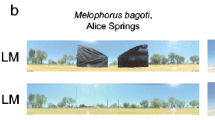Abstract.
This study investigates the ability of desert ants to adapt their path integration system to an "open-jaw" training paradigm, in which the point of arrival (from the nest) does not coincide with the point of departure (to the nest). Upon departure the ants first run off their home vector and then start a systematic search for the nest. Even if they are subjected to this training-around-a-circuit procedure for more than 50 times in succession, they never adopt straight homeward courses towards the nest. Their path integration vector gets slightly recalibrated (pointing a bit closer to the nest), and their search pattern gets asymmetric (with its search density peak shifted towards the nest), but the bipartite structure of the inbound trajectory invariably remains. These results suggest (1) that the ants cannot learn separate inbound and outbound vectors (i.e. vectors that are not 180° reversals of each other), (2) that the recalibrated vector is dominated by the ant's outbound course, (3) that the recalibration of the vector and the modification of the search geometry are fast and flexible processes occurring whenever the ant experiences a mismatch between the stored and actual states of its path integrator.
Similar content being viewed by others
Author information
Authors and Affiliations
Additional information
Electronic Publication
Rights and permissions
About this article
Cite this article
Wehner, .R., Gallizzi, .K., Frei, .C. et al. Calibration processes in desert ant navigation: vector courses and systematic search. J Comp Physiol A 188, 683–693 (2002). https://doi.org/10.1007/s00359-002-0340-8
Accepted:
Issue Date:
DOI: https://doi.org/10.1007/s00359-002-0340-8




